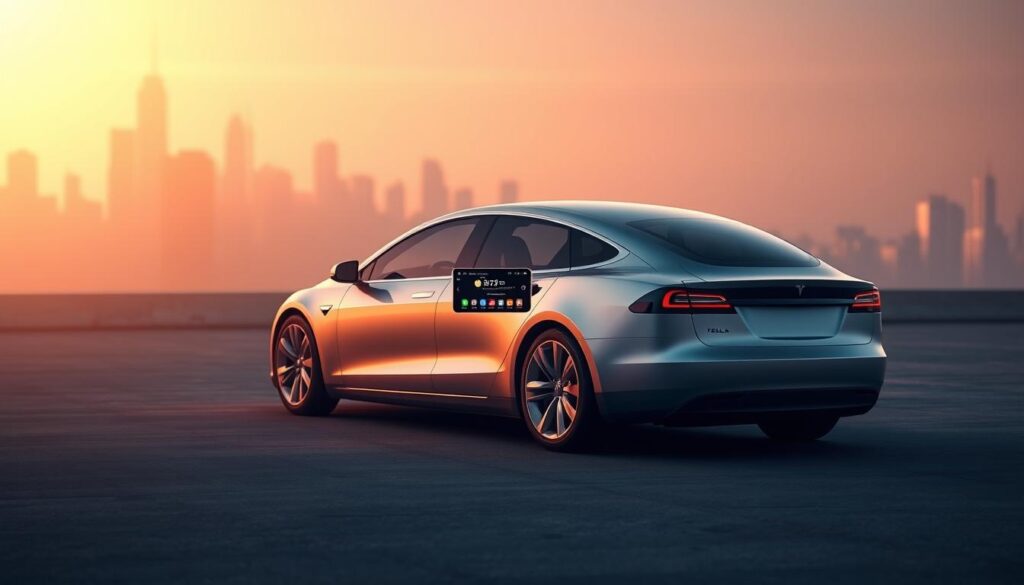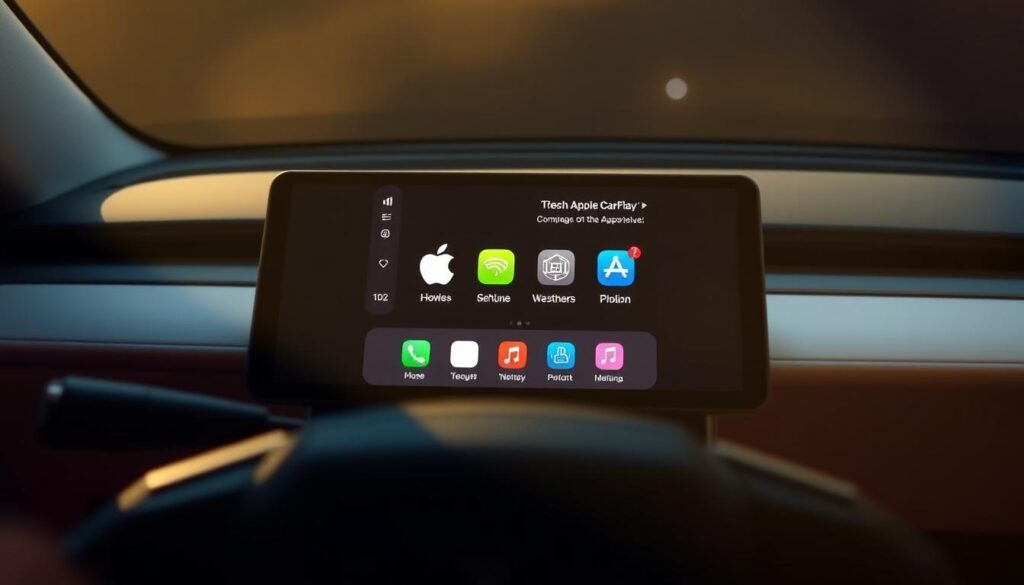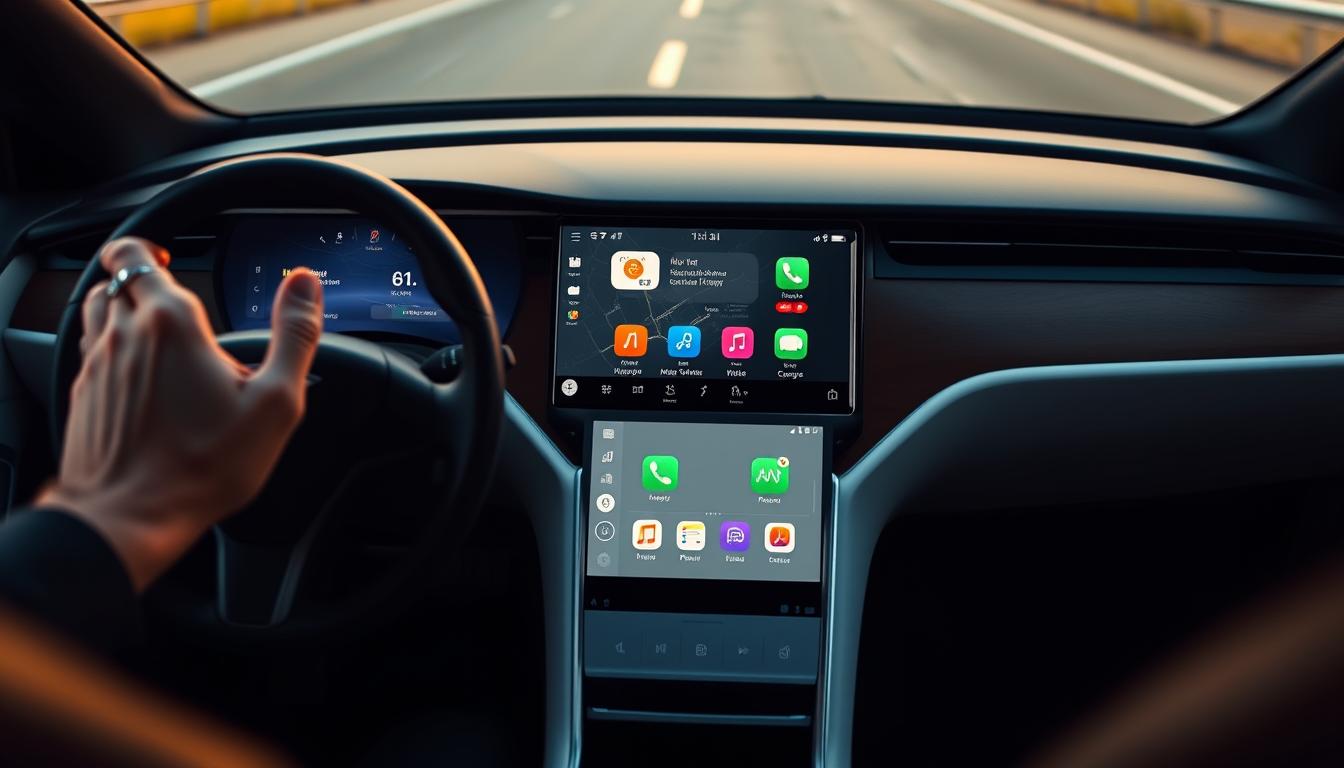Tesla proprietors now have the capability to enhance their vehicular journey by integrating Apple CarPlay into their vehicles. The Tesla infotainment system, celebrated for its cutting-edge functionalities, is further enriched by CarPlay. This integration offers users a more unified and user-friendly interface.
The fusion of Tesla CarPlay ushers in a more bespoke in-car ambiance, empowering drivers to access their preferred applications, navigate through maps, and manage their music playlists with unparalleled convenience. This comprehensive guide will elucidate the necessary steps to merge Apple CarPlay with your Tesla, thus augmenting your driving experience.
Key Takeaways
- Learn how to integrate Apple CarPlay with your Tesla vehicle.
- Understand the benefits of using CarPlay with Tesla’s infotainment system.
- Discover the steps to enhance your in-car experience.
- Explore the compatibility of Tesla models with Apple CarPlay.
- Find out how to troubleshoot common issues during integration.
The Tesla and Apple CarPlay Compatibility Challenge
The absence of native Apple CarPlay support in Tesla vehicles poses a formidable compatibility challenge. Tesla’s preference for its proprietary infotainment system over CarPlay integration has sparked controversy among users. These individuals yearn for the seamless integration that Apple’s ecosystem offers.
Why Tesla Doesn’t Include Native CarPlay Support
Tesla’s decision to eschew native CarPlay support is rooted in its dedication to a unique, integrated user experience. By crafting its own infotainment system, Tesla ensures control over the user interface. This approach guarantees that the driving environment aligns with Tesla’s futuristic vision.
Benefits of Adding CarPlay to Your Tesla Experience
Integrating CarPlay into your Tesla can profoundly elevate your driving experience. The advantages include:
- Access to a broader range of apps
- A more familiar interface for iPhone users
Enhanced App Ecosystem
CarPlay integration allows Tesla owners to access a more extensive array of apps through their vehicle’s infotainment system. This includes popular navigation apps, music streaming services, and messaging platforms. Such integration enriches the driving experience.
Familiar iPhone Interface
For iPhone users, CarPlay presents a familiar interface that mirrors their device’s home screen. This similarity simplifies navigation and app usage while driving. It reduces the learning curve and enhances safety by minimizing distractions.

Understanding the challenges and benefits of integrating CarPlay into Tesla vehicles empowers owners to make informed decisions. These decisions can significantly enhance their driving experience.
How to Use Apple CarPlay in Tesla: Overview of Methods
The pursuit of seamless Apple CarPlay integration within Tesla vehicles has precipitated the creation of multiple innovative methodologies. Tesla proprietors now possess a plethora of avenues to partake in the advantages of Apple CarPlay within their vehicles.
Hardware-Based Integration Options
One of the primary methodologies for integrating Apple CarPlay into Tesla vehicles entails hardware enhancements. This necessitates the installation of an Apple CarPlay adapter, which facilitates CarPlay functionality through the Tesla’s infotainment system. These adapters can be connected via USB or wirelessly, contingent upon the model and the adapter’s capabilities.
Several hardware-based solutions are prevalent:
- CarPlay adapters that interface with the Tesla’s USB port
- Wireless CarPlay adapters that leverage Wi-Fi and Bluetooth connectivity
- Aftermarket head units that supplant the existing Tesla infotainment system
Software and App-Based Solutions
For those eschewing hardware modifications, software and app-based alternatives present a viable option. Certain third-party applications and software updates can confer CarPlay compatibility sans the necessity for additional hardware.
Examples encompass:
- Apps that stream CarPlay content to the Tesla’s screen
- Software updates that integrate CarPlay functionality directly into the Tesla’s operating system
Wireless vs. Wired CarPlay Considerations
In deliberating upon a CarPlay integration methodology, Tesla proprietors must weigh the merits of wireless versus wired solutions. Each modality presents distinct advantages and disadvantages.
Pros and Cons of Each Approach
| Connection Type | Pros | Cons |
|---|---|---|
| Wired CarPlay | Reliable connection, less latency | Cable clutter, limited mobility |
| Wireless CarPlay | Convenience, reduced clutter | Potential for connectivity issues, higher cost |
Grasping these distinctions is imperative for Tesla proprietors to make an informed decision, aligning with their specific requirements.

Tesla Model Compatibility and Considerations
Assessing the compatibility of various Tesla models with Apple CarPlay is paramount for a seamless integration. The Tesla infotainment system’s role in facilitating this integration cannot be overstated.
Model S and Model X Integration Options
The Model S and Model X, being among the earlier iterations, present specific hardware challenges for CarPlay integration. Aftermarket solutions are available to circumvent these issues, enabling CarPlay functionality on these models.
Model 3 and Model Y Specific Solutions
The integration process for the Model 3 and Model Y is notably more straightforward, thanks to their advanced infotainment systems. Users have the option to choose between wired and wireless CarPlay solutions.
Cybertruck and Roadster Compatibility Notes
The Cybertruck and Roadster, as newer or more specialized models, necessitate unique considerations. For example, the Cybertruck’s cutting-edge infotainment system may offer more refined CarPlay integration options.
| Tesla Model | CarPlay Integration Method | Notes |
|---|---|---|
| Model S | Aftermarket Adapter | Requires additional hardware |
| Model X | Aftermarket Adapter | Similar to Model S, with some variations |
| Model 3 | Wired/Wireless CarPlay | More straightforward integration |
| Model Y | Wired/Wireless CarPlay | Shares integration methods with Model 3 |
Required Equipment and Budget Planning
Integrating Apple CarPlay into your Tesla necessitates meticulous planning, encompassing the selection of appropriate equipment and budget allocation. A thorough comprehension of the requisite hardware and software elements is paramount for a seamless integration process.
Essential Hardware Components Checklist
The hardware prerequisites for Tesla CarPlay integration center around the Apple CarPlay adapter. In the selection of an adapter, compatibility with your Tesla model and the supported connection type (wired or wireless) must be considered.
- Apple CarPlay compatible adapter
- Tesla model-specific installation kit (if required)
- Wiring and connectors for a stable connection
Software Requirements and Subscriptions
While the primary hardware component is the CarPlay adapter, certain solutions necessitate supplementary software or subscriptions for optimal functionality. This may encompass software for wireless connectivity or apps that augment the CarPlay experience.
Total Cost Analysis for Different Solutions
The total expenditure for integrating CarPlay into your Tesla fluctuates significantly based on the selected solution. A detailed cost analysis of various options is provided below:
| Solution Type | Estimated Cost | Key Features |
|---|---|---|
| Entry-Level | $100-$300 | Basic CarPlay functionality, wired connection |
| Premium | $300-$700+ | Wireless CarPlay, enhanced performance, additional features |
Entry-Level Options ($100-$300)
Entry-level solutions offer fundamental CarPlay functionality and are typically wired. They represent a cost-effective avenue to introduce CarPlay into your Tesla.
Premium Solutions ($300-$700+)
Premium solutions proffer advanced functionalities such as wireless CarPlay, superior performance, and sometimes additional capabilities like Android Auto compatibility. These solutions are tailored for users desiring a more comprehensive and premium experience.
In planning your Tesla CarPlay integration, it is essential to consider both the initial expenditure and the long-term advantages. The selection of the appropriate solution hinges on your specific requirements, budget, and Tesla model.
Method 1: Installing a CarPlay Adapter in Your Tesla
To integrate Apple CarPlay into your Tesla, a CarPlay adapter installation is required, a straightforward yet effective approach. This method enables the enjoyment of CarPlay’s benefits without necessitating the replacement of your Tesla’s infotainment system.
Step1: Selecting the Right CarPlay Adapter
The selection of an appropriate CarPlay adapter is paramount for a seamless integration. Consider the following factors when making your selection:
- Compatibility with your Tesla model
- Support for wireless or wired CarPlay
- User reviews and ratings
Recommended Brands and Models
Several renowned brands offer high-quality CarPlay adapters tailored for Tesla vehicles. Research and choose a reputable brand that aligns with your requirements and budget. For instance, brands such as CarPlay Dongle and Tesla CarPlay Adapter Pro are highly regarded in the market.
Step2: Detailed Installation Process
The installation process necessitates the access to your Tesla’s MCU and the connection of the adapter. Here’s a step-by-step guide:
Accessing the Tesla MCU
To access the MCU, you must carefully disassemble parts of your Tesla’s dashboard. Refer to your Tesla’s manual or online resources for specific instructions, as the process can vary depending on your Tesla model.
Connecting the Adapter
Once you have access to the MCU, connect the CarPlay adapter according to the manufacturer’s instructions. Ensure all connections are secure to avoid any issues during use.
Step3: iPhone Connection and Pairing
After installing the adapter, connect your iPhone to the CarPlay system using a USB cable or wirelessly, depending on your adapter’s capabilities. Follow the on-screen instructions to complete the pairing process.
Step4: Configuration and Settings Optimization
To maximize the benefits of your CarPlay integration, configure your CarPlay settings on your iPhone. You can customize various options, such as Siri integration and app visibility, to suit your preferences.
By adhering to these steps, you can successfully install a CarPlay adapter in your Tesla and enjoy a more integrated and convenient driving experience.
Method 2: Implementing Tesla Android Box Solutions
The integration of CarPlay into your vehicle’s infotainment system through Tesla Android box solutions represents a robust methodology. This approach enables Tesla proprietors to transcend the inherent limitations of native systems, thus accessing the comprehensive array of CarPlay functionalities.
Step1: Choosing a Compatible Android Box
The selection of an appropriate Android box is paramount for a seamless CarPlay integration within your Tesla. The chosen device must be compatible with your Tesla model’s infotainment system and support the most recent CarPlay functionalities.
Top Recommended Models
- Nvidia Shield: Renowned for its superior performance and extensive app compatibility.
- Xiaomi Mi Box: Presents a cost-effective alternative with substantial features.
- Google Android TV Box: Offers a straightforward, Google-endorsed solution.
Step2: Installation and Connection Procedure
The installation process necessitates both physical mounting and configuring the requisite connections.
Physical Installation
Mount the Android box in a suitable location within your Tesla, ensuring its stability and non-obstruction of other controls.
Power and Data Connections
Connect the Android box to a power source and establish the necessary data connections to your Tesla’s infotainment system. This may involve HDMI or other compatible cables.
Step3: Setting Up CarPlay Software
Post-installation of the Android box, the configuration of the CarPlay software is imperative. This entails the download and installation of any requisite apps or drivers that facilitate CarPlay functionality on your Tesla’s system.
Step4: Connecting and Testing with Your iPhone
Upon the setup of the Android box and CarPlay software, connect your iPhone to the Android box via USB or wirelessly, contingent upon your configuration. Test the CarPlay interface to verify its functionality and optimize settings as necessary for an optimal experience.
Adherence to these steps empowers Tesla proprietors to successfully implement an Android box solution, thus enabling Apple CarPlay in their vehicles. This enhances their driving experience with an integrated and feature-rich infotainment system.
Method 3: Software-Based CarPlay Integration Options
For Tesla proprietors desiring a more cohesive interaction with their iPhone, software-based CarPlay integration presents a viable alternative. This methodology obviates the necessity for supplementary hardware, capitalizing on extant technology to introduce CarPlay functionality into Tesla’s entertainment system.
Overview of Third-Party Applications
Several third-party applications have surfaced to facilitate CarPlay integration in Tesla vehicles. These software solutions are crafted to circumvent the inherent limitations of Tesla’s system, offering users a more fluid iPhone integration experience.
Tesla Android Project
The Tesla Android Project has garnered significant attention. It entails the installation of an Android-based system on the Tesla’s entertainment screen, enabling CarPlay compatibility alongside other functionalities. This endeavor is notably attractive to tech-savvy Tesla proprietors eager to explore their vehicle’s software capabilities.
CarPlay Apps for Tesla
Specialized apps have been developed to introduce CarPlay to Tesla models. These apps necessitate specific installation procedures and may involve sideloading or the utilization of intermediary devices. Users must exercise caution and verify the authenticity of sources to avert potential security threats.
Installation and Configuration Steps
The process of installing software-based CarPlay solutions encompasses several phases, including the download of requisite software, the configuration of the Tesla’s system, and potentially the sideloading of apps. It is imperative to adhere to detailed guides and instructions furnished by the software developers to guarantee a seamless installation process.
Optimizing Performance and Usability
Post-installation, the optimization of the CarPlay experience is paramount for a seamless integration. This entails the adjustment of settings within the Tesla’s system, the configuration of CarPlay preferences, and the potential tweaking of performance settings to mitigate lag or connectivity problems.
By delving into software-based CarPlay integration options, Tesla proprietors can partake in a more integrated driving experience, amalgamating the superior aspects of Tesla’s interface with the capabilities of Apple CarPlay.
Safety and Warranty Considerations
Integrating Apple CarPlay into your Tesla necessitates a thorough examination of safety and warranty implications. Modifying the Tesla infotainment system can lead to severe consequences, including potential warranty voidance. This underscores the importance of caution and informed decision-making.
Potential Impact on Tesla Warranty
The integration of CarPlay into your Tesla raises significant concerns regarding warranty implications. Alterations to the infotainment system can invalidate certain warranty provisions, resulting in substantial repair expenses. It is imperative to meticulously review Tesla’s warranty terms prior to embarking on any CarPlay integration endeavors.
Ensuring Safe Installation Practices
Adherence to established guidelines and, if necessary, professional consultation is paramount for safe installation practices. This entails the selection of compatible hardware and software that do not compromise the vehicle’s safety features or CarPlay Tesla compatibility.
Reversibility of Modifications
Understanding the reversibility of modifications is of utmost importance. Some Tesla CarPlay integration methods facilitate easier reversion to the original configuration than others.
Returning to Stock Configuration
In the event of a decision to revert your Tesla to its stock configuration, meticulous documentation of all modifications made during the CarPlay integration process is crucial. Such documentation will be instrumental in facilitating the reversal process.
Troubleshooting Common CarPlay Integration Issues
The integration of CarPlay with Tesla vehicles can be fraught with connectivity and performance challenges. It is imperative to understand how to address these issues to ensure a seamless driving experience.
Connection and Pairing Problems
Tesla owners frequently encounter connection and pairing difficulties when integrating CarPlay. These problems can arise from a variety of sources, including Bluetooth and Wi-Fi connectivity issues.
Bluetooth Connectivity Issues
Bluetooth connectivity problems can hinder the pairing of your iPhone with your Tesla’s CarPlay system. Restarting both your iPhone and Tesla’s infotainment system is often a solution to this issue.
Wi-Fi Connection Failures
Wi-Fi connection failures can also disrupt the CarPlay experience. Ensuring that both devices are connected to the same Wi-Fi network can help alleviate this problem.
Display and Performance Challenges
Users may also face display and performance challenges, such as screen mirroring lag and audio sync problems.
Screen Mirroring Lag
Screen mirroring lag can be frustrating. Updating your Tesla’s software and ensuring that your iPhone is running the latest iOS version can help reduce lag.
Audio Sync Problems
Audio sync problems can detract from the overall experience. Checking the audio settings on both your iPhone and Tesla can help synchronize the audio properly.
Software Update Complications
Software updates can sometimes cause compatibility issues between Tesla’s infotainment system and CarPlay.
Tesla Updates Breaking Compatibility
Occasionally, Tesla software updates may break CarPlay compatibility. In such cases, waiting for a subsequent update or checking for CarPlay software updates can resolve the issue.
CarPlay Software Update Issues
Updates to CarPlay software can sometimes cause issues. Ensuring that all software is up-to-date and compatible is essential.
| Issue | Troubleshooting Step |
|---|---|
| Bluetooth Connectivity | Restart iPhone and Tesla |
| Wi-Fi Connection | Ensure same Wi-Fi network |
| Screen Mirroring Lag | Update Tesla and iPhone software |
| Audio Sync Problems | Check audio settings |
Conclusion: Balancing Tesla’s Interface with Apple CarPlay Benefits
Tesla owners now have the opportunity to merge the advantages of Apple CarPlay with their vehicle’s native infotainment system. The Tesla CarPlay integration process streamlines the user experience, blending the robustness of Tesla’s interface with CarPlay’s functionalities.
Understanding the compatibility and considerations for various Tesla models is crucial. Owners can select the most appropriate method for their requirements. This includes hardware-based integration, software solutions, or Android box installations. The goal is to harmonize the native Tesla experience with the augmented capabilities of CarPlay.
The integration of CarPlay into a Tesla significantly enhances the driving experience. It provides effortless access to navigation, entertainment, and other features. As automotive technology advances, the CarPlay Tesla compatibility emerges as a compelling option for those desiring a more cohesive and user-friendly driving environment.
In conclusion, the Tesla infotainment system becomes more versatile and enjoyable, accommodating a broad spectrum of user preferences and needs.
